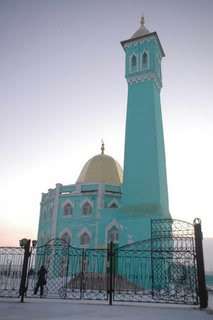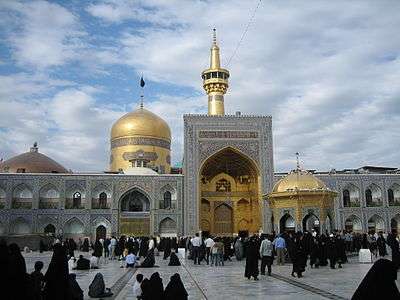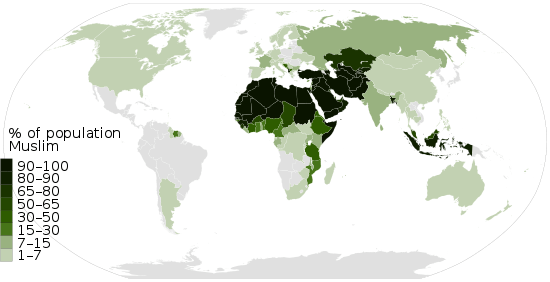Islam in Asia
Islam in Asia began in the 7th century during the lifetime of Muhammad. In 2010, the total number of Muslims in Asia was about 1.1 billion. About 62% of the world's Muslims live in Asia, with Indonesia, Pakistan, India and Bangladesh having the largest Muslim populations in the world. Asia is home to the largest Muslim population, with West Asia, Central Asia, South Asia and Southeast Asia being particularly important regions. A number of adherents of Islam have lived in Asia especially in West Asia and South Asia since the beginning of Islamic history. According to Pew in 2009 Islam was the largest religion in Asia (25%) followed by Hinduism.[1]
History
The spread of Islam outside of the Arabian peninsula and into other parts of the continent can be linked to the extensive trade routes connecting West Asia to China.
The Barmakid family was an early supporter of the Abbasid Revolution against the Umayyads and of As-Saffah. This gave Khalid ibn Barmak considerable influence, and his son Yaḥyā ibn Khālid (d. 806) was the vizier of the caliph al-Mahdi (ruled 775–785) and tutor of Hārūn ar-Rashīd (ruled 786–809). Yaḥyā's sons al-Faḍl and Ja'far (767–803) both occupied high offices under Harun. Many Barmakids were patrons of the sciences, which greatly helped the propagation of Indian science and scholarship from the neighboring Academy of Gundishapur into the Arabic world. They patronized scholars such as Gebir and Jabril ibn Bukhtishu. They are also credited with the establishment of the first paper mill in Baghdad. The power of the Barmakids in those times is reflected in The Book of One Thousand and One Nights; the vizier Ja'far appears in several stories, as well as a tale that gave rise to the expression “Barmecide feast”.
We know of Yaḥyā ibn Khālid al-Barmakī (d. 805 CE) as a patron of physicians and, specifically, of the translation of Hindu medical works into both Arabic and Persian. In all likelihood, however, his activity took place in the orbit of the caliphal court in Iraq, where at the behest of Hārūn ar-Rashīd (786–809), such books were translated into Arabic. Thus Khurāsān and Transoxiana were effectively bypassed in this transfer of learning from India to Islam, even though, undeniably the Barmakī's cultural outlook owed something to their land of origin, northern Afghanistan, and Yaḥyā al-Barmakī's interest in medicine may have derived from no longer identifiable family tradition.[2]
Many of the early governors of the Caliphate were Barmakids. Khalid ibn Barmak built Mansura, Sindh and later Baghdad. His son was the governor of what is now Azerbaijan.
Regionally
Islam in Central Asia
| Country | Total Population | Muslim Percentage | Muslim Population |
|---|---|---|---|
| 18,744,548 | 70.2%[3] | 13,158,672 | |
| 6,019,480 | 86.3%[4] | 5,194,811 | |
| 8,734,951 | 98.0%[5] | 8,560,251 | |
| 5,851,466 | 93.3% | 5,459,417 | |
| 32,653,900 | 96.5%[6] | 31,511,013 | |
| Central Asia | 72,004,345 | 88.7% | 63,884,165 |
Islam in East Asia

| Country | Total Population | Muslim Percentage | Muslim Population |
|---|---|---|---|
| 1,394,620,000 | 1.8–3.6%[7][8][9] | 25,000,000–50,000,000 | |
| 7,448,900 | 4.1% | 305,404 | |
| 658,900 | 1.5% | 10,000[10] | |
| 126,420,000 | 0.1%[11] | 126,420 | |
| 25,610,672 | 0.4% | 100,000 | |
| 51,635,256 | 0.2% | 100,000 | |
| 3,231,200 | 5.0% | 161,560 | |
| 23,577,488 | 0.3% | 70,732 | |
| East Asia | 1,633,202,416 | 3.13% | 51,080,436 |
Islam in North Asia

| Country | Total Population | Muslim Percentage | Muslim Population |
|---|---|---|---|
| 33,765,005 | 15%[12] | 5,064,750 | |
| North Asia | 33,765,005 | 15% | 5,064,750 |
Islam in South Asia
| Country | Total Population | Muslim Percentage | Muslim Population |
|---|---|---|---|
| 31,575,018 | 99.0%[13] | 31,259,267 | |
| 165,000,000 | 90.4% | 149,100,000 | |
| 727,145 | 0.2%[14] | <10,000 | |
| 1,338,270,000 | 14.2%[15] | 194,600,000 | |
| 378,114 | 100%[16] | 378,114 | |
| 29,218,867 | 4.4% | 1,285,630 | |
| 212,742,631 | 96.2%[17] | 204,828,605 | |
| 21,444,000 | 9.7% | 2,080,068 | |
| South Asia | 1,789,309,144 | 36.39% | 651,090,456 |
Islam in Southeast Asia
| Country | Total Population | Muslim Percentage | Muslim Population |
|---|---|---|---|
| 443,593 | 82.7% | 366,851 | |
| 16,204,486 | 1.9%[18] | 312,540 | |
| 1,291,358 | 0.3% | 4,000 | |
| 260,580,739 | 87.2% | 227,226,404 | |
| 7,126,706 | 0.01% | 8,000 | |
| 31,381,992 | 61.3% | 19,500,000 | |
| 55,123,814 | 4.15% | 2,300,000 | |
| 106,000,000 | 5–11.0%[19][20][21] | 5,300,000–10,600,000 | |
| 5,888,926 | 15.0% | 883,338 | |
| 68,414,135 | 5.0% | 3,420,706 | |
| 96,160,163 | 0.1%[22] | 65,000 | |
| Southeast Asia | 641,775,797 | 41.3% | 264,786,839 |
Islam in West Asia

| Country | Total Population | Muslim Percentage | Muslim Population |
|---|---|---|---|
| 2,975,000 | 0.03%[23] | 1,000 | |
| 10,027,874 | 96.9%[24] | 9,727,038 | |
| 1,496,300 | 81.2%[25] | 1,214,995 | |
| 854,800 | 25.4% | 217,119 | |
| 3,723,464 | 10.7% | 463,062 | |
| 81,871,500 | 99.4% | 81,380,271 | |
| 39,339,753 | 98.0%[26] | 38,552,957 | |
| 8,930,680 | 17.7% | 1,580,730 | |
| 10,261,300 | 94.0% | 9,645,622 | |
| 4,226,920 | 85.0% | 3,592,882 | |
| 6,093,509 | 54.0% | 3,200,000 | |
| 4,651,706 | 99.0%[27] | 4,605,188 | |
| 4,816,503 | 93.0%,[28] | 4,479,347 | |
| 2,561,643 | 77.5%[29] | 1,985,273 | |
| 33,413,660 | 100.0%[30] | 33,413,660 | |
| 18,284,407 | 87.0%[31] | 15,907,434 | |
| 80,810,525 | 99.8%[32] | 80,648,903 | |
| 9,582,340 | 80.0% | 7,665,872 | |
| 28,915,284 | 100.0%[33] | 28,915,284 | |
| West Asia | 352,837,168 | 93.26% | 329,065,133 |
References
- accessed April 3, 2012. Archived January 18, 2013, at the Wayback Machine
- History of Civilizations of Central Asia, Volume 4, Part 2 By C. E. Bosworth, M.S. Asimov, page 300
- "The results of the national population census in 2009". Agency of Statistics of the Republic of Kazakhstan. 12 November 2010. Archived from the original on 22 July 2011. Retrieved 21 January 2010.
- MAPPING THE GLOBAL MUSLIM POPULATION Archived 2011-05-19 at the Wayback Machine. A Report on the Size and Distribution of the World’s Muslim Population. Pew Research Center. October 2009
- "Tajikistan". U.S. Department of State. Retrieved 14 February 2015.
- "The Future of World Religions: Population Growth Projections, 2010–2050". Pew Research. Retrieved 2 April 2015.
- "East Asia/Southeast Asia :: China — The World Factbook – Central Intelligence Agency". www.cia.gov. Retrieved 14 December 2018.
- "China Religion Facts & Stats". www.nationmaster.com. Retrieved 14 December 2018.
- Refugees, United Nations High Commissioner for. "Refworld | 2010 Report on International Religious Freedom - China (includes Tibet, Hong Kong, Macau)". Refworld. Retrieved 2018-10-15.
- "MACAU DAILY TIMES - Being a Muslim in Macau: Indonesian community holds triple celebration". 2013-10-16. Archived from the original on 2013-10-16. Retrieved 2018-10-15.
- Editors. "From 2 Mosques to 200: Growth of Islam in Japan". Muslim Ink. Retrieved 2018-10-15.CS1 maint: extra text: authors list (link)
- "Book review: Russia's Muslim Heartlands reveals diverse population", The National, 21 April 2018, retrieved 13 January 2019
- "Afghanistan Religion | Afghanistan's Web Site". www.afghanistans.com. Retrieved 2018-10-15.
- Pew Research Center's Religion & Public Life Project: Bhutan. Pew Research Center. 2010.
- "Muslim Population in India - Muslims in Indian States". www.indiaonlinepages.com. Archived from the original on 8 September 2017. Retrieved 4 October 2017.
- "The World Factbook — Central Intelligence Agency". www.cia.gov. Retrieved 2018-10-15.
- "Population by Religion", Pakistan Bureau of Statistics, retrieved 2019-01-09
- "East Asia/Southeast Asia :: Cambodia — The World Factbook – Central Intelligence Agency". www.cia.gov. Retrieved 14 December 2018.
- "Table 1.10; Household Population by Religious Affiliation and by Sex; 2010" (PDF). 2015 Philippine Statistical Yearbook. East Avenue, Diliman, Quezon City, Philippines: Philippine Statistics Authority: 1–30. October 2015. ISSN 0118-1564. Archived (PDF) from the original on 11 October 2016. Retrieved 15 August 2016.
- Philippines. 2013 Report on International Religious Freedom (Report). United States Department of State. July 28, 2014. SECTION I. RELIGIOUS DEMOGRAPHY.
The 2000 survey states that Islam is the largest minority religion, constituting approximately 5 percent of the population. A 2012 estimate by the National Commission on Muslim Filipinos (NCMF), however, states that there are 10.7 million Muslims, which is approximately 11 percent of the total population.
- "Philippines".
- "Only Few Know Of The Cham Muslims – Vietnam's Isolated Islamic Community", Mvslim, 2018-11-18, retrieved 2019-01-09
- Miller, Tracy, ed. (October 2009), Mapping the Global Muslim Population: A Report on the Size and Distribution of the World’s Muslim Population (PDF), Pew Research Center, p. 31, archived from the original (PDF) on 2009-10-10, retrieved 2009-10-08
- "Mapping The Global Muslim Population" (PDF). Archived from the original (PDF) on 19 May 2011. Retrieved 22 May 2011.
- "Bahrain Religion Facts & Stats". www.nationmaster.com. Retrieved 2018-10-15.
- "The World Factbook — Central Intelligence Agency". www.cia.gov. Retrieved 2018-10-18.
- "Oman Religion Facts & Stats". www.nationmaster.com. Retrieved 2018-10-15.
- "Are all Palestinians Muslim?". Institute for Middle East Understanding. Archived from the original on 13 April 2014. Retrieved 16 April 2014.
- "Qatar | The World Almanac of Islamism". almanac.afpc.org. Retrieved 2018-10-15.
- "Saudi Arabia". U.S. Department of State. Retrieved 2018-10-15.
- "Syria Religions - Demographics". www.indexmundi.com. Retrieved 2018-10-15.
- "Turkey". World Factbook. CIA. 2007.
- "Yemen". WikiShia. Retrieved 2018-10-18.



